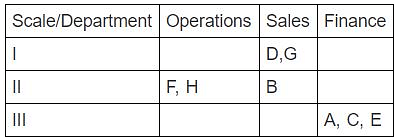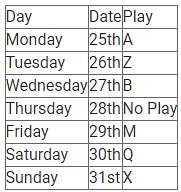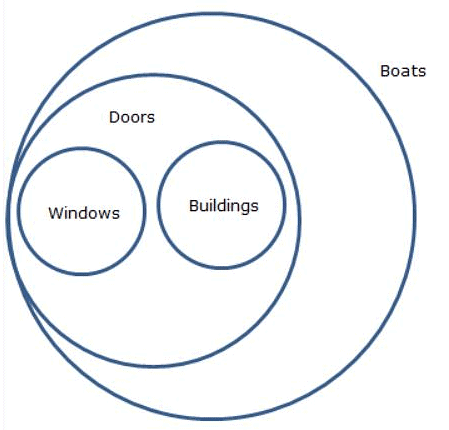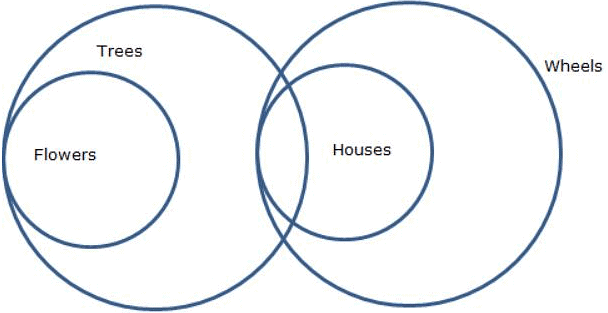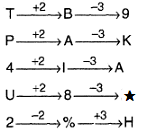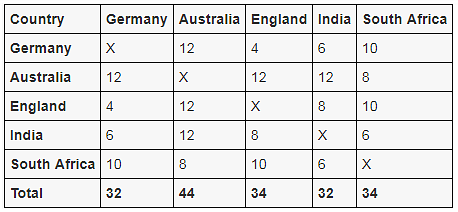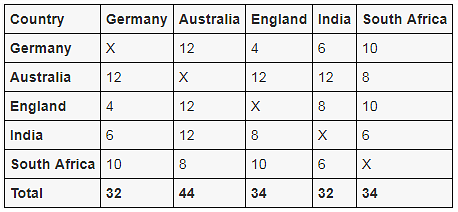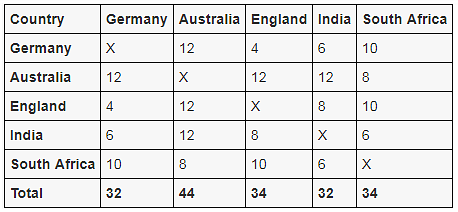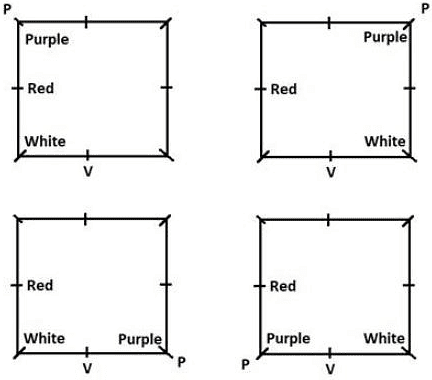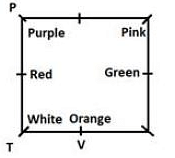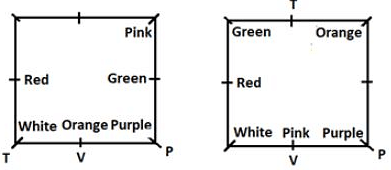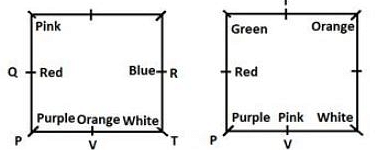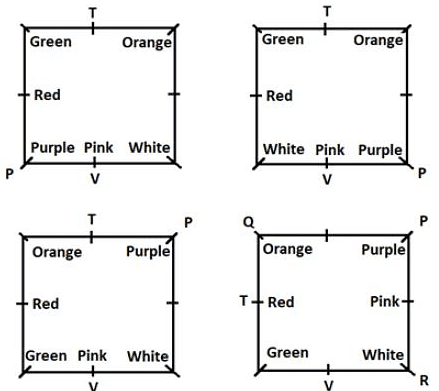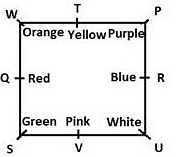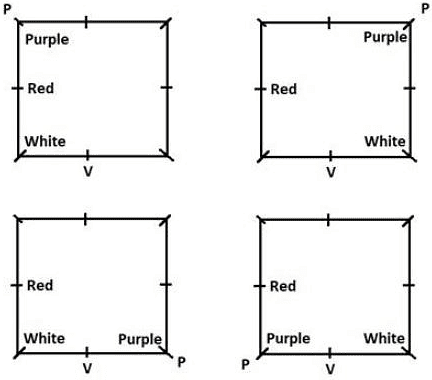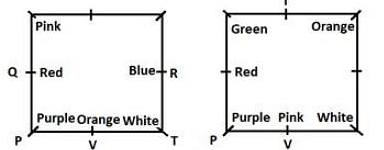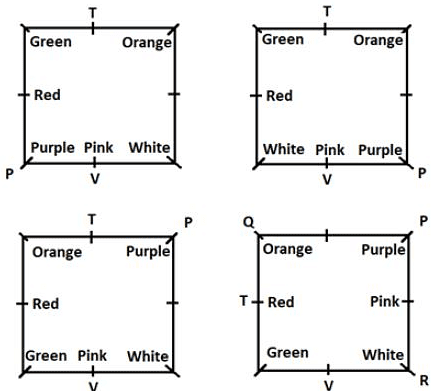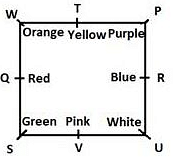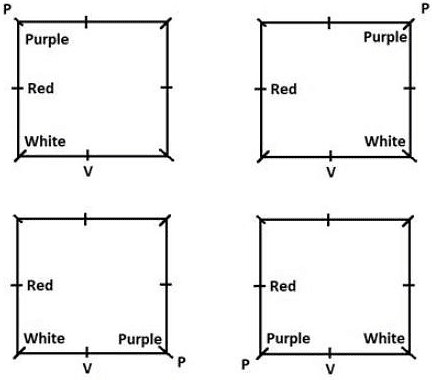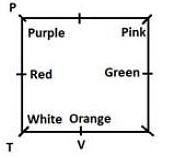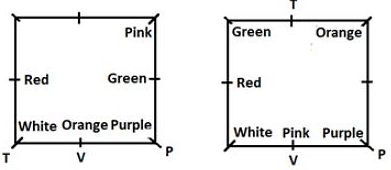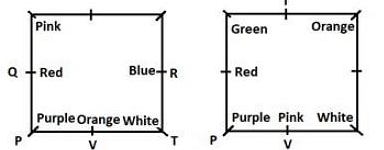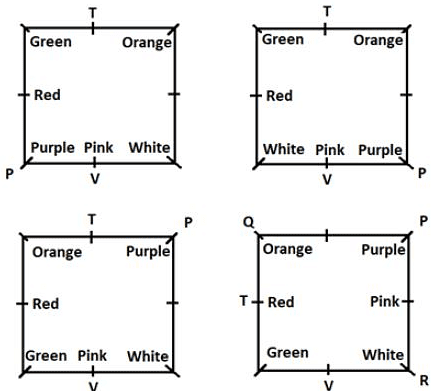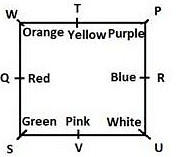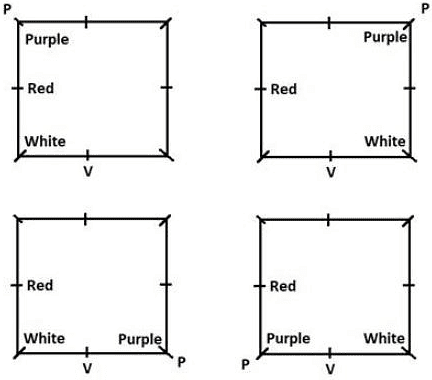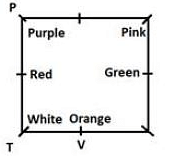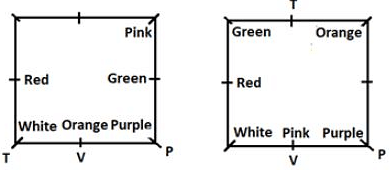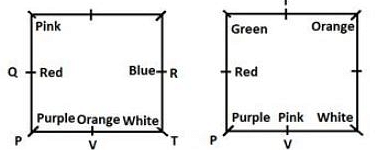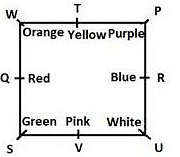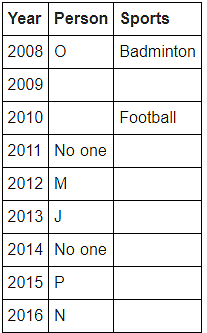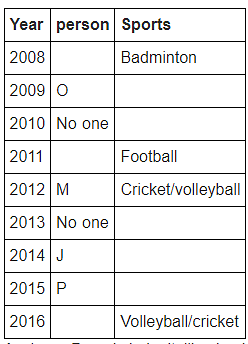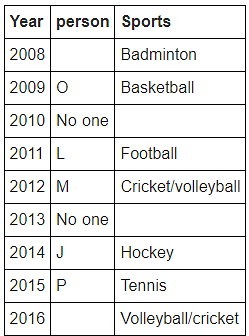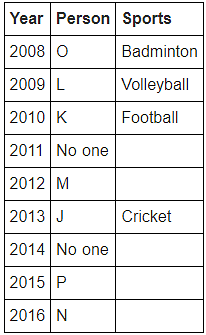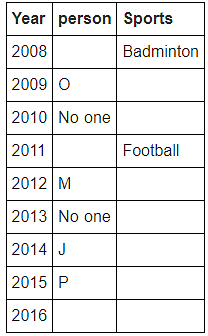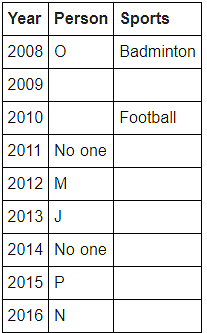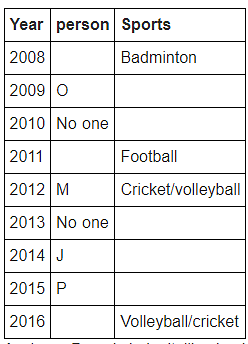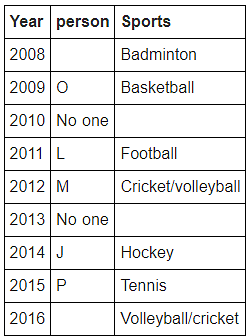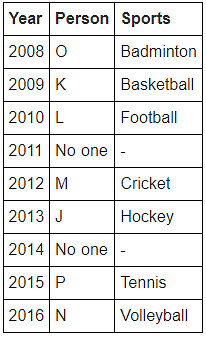MAH-CET MBA Mock Test- 12 - CAT MCQ
30 Questions MCQ Test - MAH-CET MBA Mock Test- 12
Directions: Study the following information carefully and answer the questions given below :
A. B. C, D, E, F, G and H are eight persons working in three different departments viz. Operations, Sales and Finance of an organisation with at least two and not more than three in any department. They are in three different scales viz. I, II and III with at least two and maximum three in any one scale.
Both the employees in Operations departments are in Scale II. D works in the Sales department and belongs to Scale I. A works in Finance departments and does not belong to Scale I. Two employees in the Sales department belong to scale I. F works with only H in one of the departments. C works with E in one of the departments. B does not work with either C or A in the same department and B is in scale II. G does not belong to Scale III. E does not belong to Scale I. Only sales department’s persons are in scale I.
Which of the following combinations is correct?
Directions: Study the following information carefully and answer the questions given below :
A. B. C, D, E, F, G and H are eight persons working in three different departments viz. Operations, Sales and Finance of an organisation with at least two and not more than three in any department. They are in three different scales viz. I, II and III with at least two and maximum three in any one scale.
Both the employees in Operations departments are in Scale II. D works in the Sales department and belongs to Scale I. A works in Finance departments and does not belong to Scale I. Two employees in the Sales department belong to scale I. F works with only H in one of the departments. C works with E in one of the departments. B does not work with either C or A in the same department and B is in scale II. G does not belong to Scale III. E does not belong to Scale I. Only sales department’s persons are in scale I.
H belongs to which scale?
| 1 Crore+ students have signed up on EduRev. Have you? Download the App |
Directions: Study the following information carefully and answer the questions given below :
A. B. C, D, E, F, G and H are eight persons working in three different departments viz. Operations, Sales and Finance of an organisation with at least two and not more than three in any department. They are in three different scales viz. I, II and III with at least two and maximum three in any one scale.
Both the employees in Operations departments are in Scale II. D works in the Sales department and belongs to Scale I. A works in Finance departments and does not belong to Scale I. Two employees in the Sales department belong to scale I. F works with only H in one of the departments. C works with E in one of the departments. B does not work with either C or A in the same department and B is in scale II. G does not belong to Scale III. E does not belong to Scale I. Only sales department’s persons are in scale I.
C belongs to which scale?
Directions: Study the following Information to answer the given questions:
(a) Six plays are to be organized from Monday to Sunday -One play each day with one day when there is no play. 'No play' day is not Monday or Sunday.
(b) The plays are held in sets of 3 plays each in such a way that 3 plays are held without any break i.e. 3 plays are held in such a way, that there is no 'No play' day between them but immediately before this set or immediately after this set it is 'No play' day.
(c) Play Z is held on 26th and play X was held on 31st of the same month.
(d) Play B was not held immediately after play A (but was held after A, not necessarily immediately) and play M was held immediately before Q.
(e) All the six plays were held in the same month.
Which day was play Z organized?
Directions: Study the following Information to answer the given questions:
(a) Six plays are to be organized from Monday to Sunday -One play each day with one day when there is no play. 'No play' day is not Monday or Sunday.
(b) The plays are held in sets of 3 plays each in such a way that 3 plays are held without any break i.e. 3 plays are held in such a way, that there is no 'No play' day between them but immediately before this set or immediately after this set it is 'No play' day.
(c) Play Z is held on 26th and play X was held on 31st of the same month.
(d) Play B was not held immediately after play A (but was held after A, not necessarily immediately) and play M was held immediately before Q.
(e) All the six plays were held in the same month.
Which of the following is true?
In the question below, a statement followed by two assumptions numbered I and II. An assumption is something supposed or taken for granted. You have to consider the statement and the following assumptions and decide which of the assumptions is implicit in the statement.
Statement: The government announced a heavy compensation package for all the victims of the terrorist attacks.
Assumptions:
I. Such incidents of terror may not occur in near future.
II. Compensation may mitigate the anger among the citizens against the current government.
Two statements are followed by two inferences. Select
Option a: if only inference 1 follows.
Option b: if only inference 2 follows.
Option c: if both of them follow.
Option d: if neither of them follows.
Option e: Insufficient data.
Either you leave now or you will miss the train. You do not leave now. So
1. You will miss the train.
2. You will not miss the train.
Directions: In making decisions about important questions, it is desirable to be able to distinguish between ‘strong’ arguments and ‘weak’ arguments. ‘Strong’ arguments are those which are both important and directly related to the question. ‘Weak’ arguments are those which are of minor importance and also may not be directly related to the question or may be related to a trivial aspect of the question. Each question below is followed by two arguments numbered I and II. You have to decide which of the argument is a ‘strong’ argument and which is a ‘weak’ argument.
Statement: Should there be only two political parties in India?
Arguments:
I. Yes, in many developed countries there are only two political-parties.
II. No, Indian electorate is not matured to select between only two political parties.
Directions: In these questions the symbols @, #, Ú, $ and © are used with different meanings as follow:
‘A @ B’ means ‘A is not greater than B’.
‘A # B’ means ‘A is neither greater than nor equal to B’.
‘A Ú B’ means ‘A is not smaller than B’.
‘A $ B’ means ‘A is neither smaller than nor equal to B’.
‘A © B’ means ‘A is neither greater than nor smaller than B’.
Now in each of the following questions assuming the given statements to be true, find out which of the conclusions I, II, III given below them is/are definitely true and mark your answer accordingly.
Statements: H @ I, I # L, L Ú A, A $ Q
Conclusions:
I. H # L
II. H Ú L
III. Q # H
In the question below, three statements are given followed by three conclusions numbered I, II & III. You have to take the given statements to be true even if they seem to be at variance from commonly known facts. Read all the conclusions and then decide which of the given conclusions logically follows from the given statements disregarding commonly known facts.
Statements: All windows are doors. All buildings are doors. All doors are boats.
Conclusions: I. All windows are boats.
II. All buildings are boats.
III. Some boats are doors.
In the question below, three statements are given followed by three conclusions numbered I, II & III. You have to take the given statements to be true even if they seem to be at variance from commonly known facts. Read all the conclusions and then decide which of the given conclusions logically follows from the given statements disregarding commonly known facts.
Statements: All flowers are trees. Some trees are houses. All houses are wheels.
Conclusions: I. Some wheels are trees.
II. Some trees are flowers.
III. Some wheels are flowers.
Direction: Study the following arrangement carefully and answer the question given below:
R D @ 5 M E 7 9 T © B % W 2 H 6 $ K P 1 A 4 Q I V * U N 8 3 Z F Y
Four of the following five are alike in a certain way based on their positions in the above arrangement and so form a group. Which is the one that does not belong to that group?
Direction: The question below consists of a question and two/three statements numbered 1 and 2/3. You have to decide whether the data provided in the statements are sufficient to answer the question.
Who is the sister –in-law of Tarun?
1. Tarun is the father of Vikas and is married to sister of Ashok.
2. Milan and Anushka are two sisters of Ashok.
3. Only Milan is childless.
Direction: The question below consists of a question and two/three statements numbered 1 and 2/3. You have to decide whether the data provided in the statements are sufficient to answer the question.
How many hits does a website ‘X’ receive (in exact figures)?
1. The sum of all hits is twenty times per minute hits.
2. The average of all hits is 7000 per month.
3. The website gets 10 hours of response every day.
Directions: A study was conducted to ascertain the relative popularity of five different sports in five different countries. The sports, as a part of the study are Hockey, Badminton, Cricket, Wrestling and Soccer. The countries in question are Germany, Australia, England, India and South Africa. The level of dissimilarity between any two countries is measured by the total difference in the ranks allotted by the two countries for all the five sports combined. A lower score of dissimilarity indicates similar sports preferences between the two countries.
The following table indicates the rank order of the five sports for each country.

Which countries sports preferences is most similar to Australia?
Directions: A study was conducted to ascertain the relative popularity of five different sports in five different countries. The sports, as a part of the study are Hockey, Badminton, Cricket, Wrestling and Soccer. The countries in question are Germany, Australia, England, India and South Africa. The level of dissimilarity between any two countries is measured by the total difference in the ranks allotted by the two countries for all the five sports combined. A lower score of dissimilarity indicates similar sports preferences between the two countries.
The following table indicates the rank order of the five sports for each country.
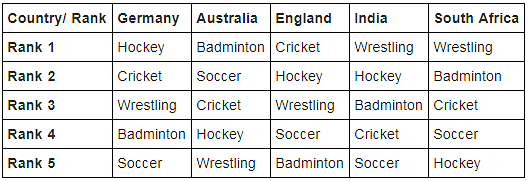
Directions: A study was conducted to ascertain the relative popularity of five different sports in five different countries. The sports, as a part of the study are Hockey, Badminton, Cricket, Wrestling and Soccer. The countries in question are Germany, Australia, England, India and South Africa. The level of dissimilarity between any two countries is measured by the total difference in the ranks allotted by the two countries for all the five sports combined. A lower score of dissimilarity indicates similar sports preferences between the two countries.
The following table indicates the rank order of the five sports for each country.
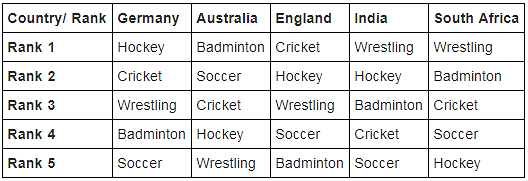
Directions: Eight racers P, Q, R, S, T, U, V and W were seated around a square table discussing about their upcoming racing event. They were seated facing inside the center and there was one person on every side and one person on every corner. Each racer had a different coloured car. The colours were red, green, yellow, purple, pink, blue, orange and white not necessarily in the same order.
• T was seated opposite to the person who owned the pink car.
• The one who owned the orange car was neighbouring T and was 2nd to the left of the one who owned the green car.
• The person with the red car was at one of the sides and was 2nd to the left of V.
• V's neighbour who owned a white car was at a gap of 1 from P who owned the purple car.
• W was seated to the immediate right of the one with the yellow car.
• Q faced R who owned either white or blue car.
• U was 2nd to the right of S who did not own the white or orange car.
Who among the following was seated 3rd to the right of the one who owned the green car?
Directions: Eight racers P, Q, R, S, T, U, V and W were seated around a square table discussing about their upcoming racing event. They were seated facing inside the center and there was one person on every side and one person on every corner. Each racer had a different coloured car. The colours were red, green, yellow, purple, pink, blue, orange and white not necessarily in the same order.
• T was seated opposite to the person who owned the pink car.
• The one who owned the orange car was neighbouring T and was 2nd to the left of the one who owned the green car.
• The person with the red car was at one of the sides and was 2nd to the left of V.
• V's neighbour who owned a white car was at a gap of 1 from P who owned the purple car.
• W was seated to the immediate right of the one with the yellow car.
• Q faced R who owned either white or blue car.
• U was 2nd to the right of S who did not own the white or orange car.
Which of the following cars was owned by W?
Directions: Eight racers P, Q, R, S, T, U, V and W were seated around a square table discussing about their upcoming racing event. They were seated facing inside the center and there was one person on every side and one person on every corner. Each racer had a different coloured car. The colours were red, green, yellow, purple, pink, blue, orange and white not necessarily in the same order.
• T was seated opposite to the person who owned the pink car.
• The one who owned the orange car was neighbouring T and was 2nd to the left of the one who owned the green car.
• The person with the red car was at one of the sides and was 2nd to the left of V.
• V's neighbour who owned a white car was at a gap of 1 from P who owned the purple car.
• W was seated to the immediate right of the one with the yellow car.
• Q faced R who owned either white or blue car.
• U was 2nd to the right of S who did not own the white or orange car.
Who among the following was seated to the immediate left of Q?
Directions: Eight racers P, Q, R, S, T, U, V and W were seated around a square table discussing about their upcoming racing event. They were seated facing inside the center and there was one person on every side and one person on every corner. Each racer had a different coloured car. The colours were red, green, yellow, purple, pink, blue, orange and white not necessarily in the same order.
• T was seated opposite to the person who owned the pink car.
• The one who owned the orange car was neighbouring T and was 2nd to the left of the one who owned the green car.
• The person with the red car was at one of the sides and was 2nd to the left of V.
• V's neighbour who owned a white car was at a gap of 1 from P who owned the purple car.
• W was seated to the immediate right of the one with the yellow car.
• Q faced R who owned either white or blue car.
• U was 2nd to the right of S who did not own the white or orange car.
Which of the following coloured cars was owned by the person who was seated 2nd to the left of Q?
Directions: A word and number arrangement machine when given an input line of words and numbers rearranges them following a particular rule in each step. The following is an illustration of input rearrangement.
Input - delivery screen independence vegetable 79 269 base 107 109 53 229
Step-1: 53 delivery screen independence vegetable 79 269 base 107 109 229
Step-2: 53 vegetable delivery screen independence 79 269 base 107 109 229
Step-3: 53 vegetable 79 delivery screen independence 269 base 107 109 229
Step-4: 53 vegetable 79 screen delivery independence 269 base 107 109 229
Step-5: 53 vegetable 79 screen 107 delivery independence 269 base 109 229
Step-6: 53 vegetable 79 screen 107 independence delivery 269 base 109 229
Step-7: 53 vegetable 79 screen 107 independence 109 delivery 269 base 229
Step-8: 53 vegetable 79 screen 107 independence 109 delivery 229 269 base
Step-9: 53 vegetable 79 screen 107 independence 109 delivery 229 base 269
Step-9 is the last step of the given input.
Answer the following questions for the below input:
Input - tennis piano 2 163 dad stock 223 29 67 button 227
What is step-4?
Directions: A word and number arrangement machine when given an input line of words and numbers rearranges them following a particular rule in each step. The following is an illustration of input rearrangement.
Input - delivery screen independence vegetable 79 269 base 107 109 53 229
Step-1: 53 delivery screen independence vegetable 79 269 base 107 109 229
Step-2: 53 vegetable delivery screen independence 79 269 base 107 109 229
Step-3: 53 vegetable 79 delivery screen independence 269 base 107 109 229
Step-4: 53 vegetable 79 screen delivery independence 269 base 107 109 229
Step-5: 53 vegetable 79 screen 107 delivery independence 269 base 109 229
Step-6: 53 vegetable 79 screen 107 independence delivery 269 base 109 229
Step-7: 53 vegetable 79 screen 107 independence 109 delivery 269 base 229
Step-8: 53 vegetable 79 screen 107 independence 109 delivery 229 269 base
Step-9: 53 vegetable 79 screen 107 independence 109 delivery 229 base 269
Step-9 is the last step of the given input.
Answer the following questions for the below input:
Input - tennis piano 2 163 dad stock 223 29 67 button 227
In step-6, what is third element from left?
Directions: A word and number arrangement machine when given an input line of words and numbers rearranges them following a particular rule in each step. The following is an illustration of input rearrangement.
Input - delivery screen independence vegetable 79 269 base 107 109 53 229
Step-1: 53 delivery screen independence vegetable 79 269 base 107 109 229
Step-2: 53 vegetable delivery screen independence 79 269 base 107 109 229
Step-3: 53 vegetable 79 delivery screen independence 269 base 107 109 229
Step-4: 53 vegetable 79 screen delivery independence 269 base 107 109 229
Step-5: 53 vegetable 79 screen 107 delivery independence 269 base 109 229
Step-6: 53 vegetable 79 screen 107 independence delivery 269 base 109 229
Step-7: 53 vegetable 79 screen 107 independence 109 delivery 269 base 229
Step-8: 53 vegetable 79 screen 107 independence 109 delivery 229 269 base
Step-9: 53 vegetable 79 screen 107 independence 109 delivery 229 base 269
Step-9 is the last step of the given input.
Answer the following questions for the below input:
Input - tennis piano 2 163 dad stock 223 29 67 button 227
f 'Tennis' is to 'dad' in step-1, 'piano' is to 'stock' in step-2, 'dad' is to 'button' in step-3, then,in step-4 'stock' is to?
Directions: Answer the questions based on the information given below.
Seven friends namely J, K, L, M, N, O and P got married but not necessarily in the same order, in seven different years from 2008 to 2016. Each of them likes a different game among Cricket, Tennis, Badminton, Football, Volleyball, Basketball and Hockey, not necessarily in the same order. No two friends got married in the same year.
1. N got married in a leap year. M got married in 2012.
2. The one who plays Badminton got married in 2008. Only two people got married in the years that are between the years when P and the one who likes Football got married.
3. P got married after the one who likes Football. Only two people were unmarried amongst seven friends in the year when J got married.
4. P got married in a year divisible by 5. There is a difference of 5 between the years when J and O got married.
5. There is one odd numbered and one even numbered year in which nobody amongst the friends got married. M doesn't like football.
6. Only two people got married in the years that are between the years when the persons who like Cricket and Volleyball got married. The one who likes Cricket got married after the one who likes football.
7. O doesn't like Volleyball. Either L got married in an odd numbered year or J likes Hockey.
8. The first person who got married after J didn't like Hockey.
9. P and J don't like Basketball. Only if K got married in odd numbered year then O doesn't like Basketball. N doesn't like Cricket.
10. If N got married in 2016 then L doesn't like Basketball.
K likes which game?
Directions: Answer the questions based on the information given below.
Seven friends namely J, K, L, M, N, O and P got married but not necessarily in the same order, in seven different years from 2008 to 2016. Each of them likes a different game among Cricket, Tennis, Badminton, Football, Volleyball, Basketball and Hockey, not necessarily in the same order. No two friends got married in the same year.
1. N got married in a leap year. M got married in 2012.
2. The one who plays Badminton got married in 2008. Only two people got married in the years that are between the years when P and the one who likes Football got married.
3. P got married after the one who likes Football. Only two people were unmarried amongst seven friends in the year when J got married.
4. P got married in a year divisible by 5. There is a difference of 5 between the years when J and O got married.
5. There is one odd numbered and one even numbered year in which nobody amongst the friends got married. M doesn't like football.
6. Only two people got married in the years that are between the years when the persons who like Cricket and Volleyball got married. The one who likes Cricket got married after the one who likes football.
7. O doesn't like Volleyball. Either L got married in an odd numbered year or J likes Hockey.
8. The first person who got married after J didn't like Hockey.
9. P and J don't like Basketball. Only if K got married in odd numbered year then O doesn't like Basketball. N doesn't like Cricket.
10. If N got married in 2016 then L doesn't like Basketball.
In which of the following years, nobody got married?
Should vaccination for life-threatening diseases be made compulsory for children?
I. Yes, because this would be a financial relief on the State's health system.
II. Yes, because parents do not have the absolute right to put their child at risk from these diseases.
If A > M = K ≤ R ≥ T > L = S is true then which of the following is definitely true?
If 'SECRET' is written as 'CRETSE', then 'CHOICE' is written as:
Directions: Study the following information carefully and answer the questions given below:
'negative easily search field' is written as 'D7F M6J M7B W9F'
'home population showed tribes' is written as 'N5P F7I F7S P11P'
'pick finance symbols banned' is written as 'D8J D5J M8Z F7B'
'across historic cabinet hailed' is written as 'J8J T7D F8B F7B'
'F7B' is the code of which of the following?


